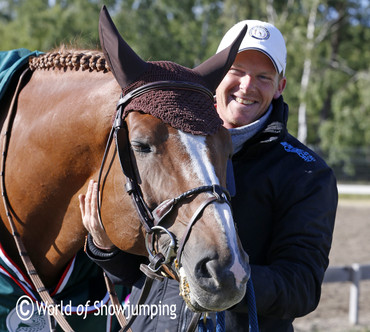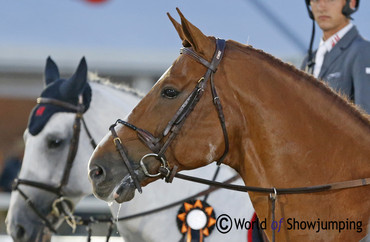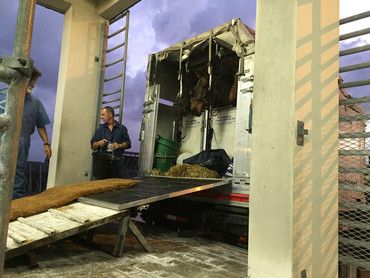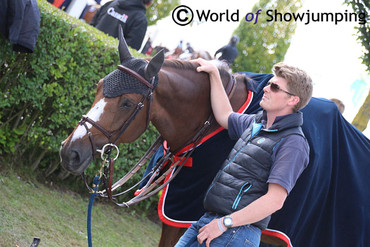Ring refinement…

Alex Tyler-Morris and Emerald. Photo (c) Jenny Abrahamsson.
“Basically the key to a good looking horse is proper brushing every day. It is not enough to give them a bath before the show, they need to be given a real brush every day. That also will avoid skin irritations, and will make them look a lot better. You can always tell horses that get brushed properly apart from those that just had a bath.
At the shows I try to not wash them too much unless they are very sweaty. I don’t think a lot of washing does the skin good. Normally I will brush them properly, and go over them with a wet cloth with Detol just to clean everything out. Detol cleans the grease away from the horses. What is important is to not use huge amounts of it, and dilute it with water – otherwise it can dry the skin out. It’s like a disinfectant, so if you have any bacteria or anything it is also good for killing that.
For the plaits I always keep them tight. You also have to find out what kind of length and thickness you want on the mane to get the plaits you want. Then everybody has different ways of doing it; I don’t like too many plaits – but that is personal taste. I like to have around 18.
For the hooves, I prefer grease to oil. It is easier to work with. I also always pay attention to keep the frog in good condition, I put grease on every day and for special circumstances Cavalor Dry Feet works really well – but you do have to be aware of how you use it. It needs to be directly on to the frog, and nowhere else.”
Tack…

"We use CWD which has very good quality on their products," Alex says when speaking of tack advice. Photo (c) Jenny Abrahamsson.
“The most important for me is that the tack is strong. I don’t like tack that is too weak, then you have to change it often or it breaks when you don’t want it to. We use CWD which has very good quality on their products.
A good saddle soap is also necessary. I use Stubben saddle soap, because I don’t like the tack to get too greasy. So first, I clean with water and then with saddle soap – with separate sponges.
For brand new leather products, it is important to put a proper conditioner on it. CWD has a very good one that I use when we get new tack in. This way I avoid dry tack, and it lasts longer.
When it comes to the rest of the equipment, I am quite simple and old fashioned. A sheep skin pad and a good quality saddle pad, and that’s it. And maybe a slip pad if the horse needs it.”
Travelling...

"When flying, the most important thing is knowing your horse," Alex says. Photo (c) private.
”It is important that it does not get too hot in the lorry, then the horses easily get uncomfortable and start to move around too much. If they are too hot they get easier agitated, irritated and stressed. So, better always have air flowing through. If I think I need to stop and check them I will, but usually I keep an eye on the temperature and normally go by that.
If you have a bad traveller you have to play around a bit and see, but a lot of them then usually are better off in the back or in the middle of the lorry. If I have stallions on, I normally always put them in the back of the lorry. If there is a problem it would normally be with the stallions, and then I don’t have to walk underneath them anywhere in the lorry.
When flying, the most important thing is knowing your horse. You have to know if they get easily stressed, if moving the containers will set them off or something like this. Normally, I only take one hay net – many people take two, but I don’t like to give hay the whole flight. I try to keep everything in a normal system. They don’t eat hay all night at home so why would I give it on the plane the whole night? So I try to keep it quite normal, and then I don’t have too many problems. If there is one that is a bit prone to sickness, give fluid. And again; make sure that the horses are not too warm.”
Feeding…

For the horses, Alex tries to keep things normal at the shows and as close to the routines at home - with some exceptions of course. Photo (c) Jenny Abrahamsson.
“A lot of the time it is the same as at home. One difference is that we don’t feed lunch at home, but at the shows I do as I never know when they will get their feed in the evening with the classes and the schedules.
Then if one needs to get a bit fresher, I add power with a bit more competition mix or oats. Normally, I don’t use anything to calm them down. I find that if you have a stressed horse, it helps a lot to put them on straw. That is of course hard if they eat a lot, then they would normally need to stay on shavings – but some of my horses that are on shavings at home I put on straw at the shows. It keeps them quiet and more relaxed. Also, if the horse is stressed take it out of the box for a few minutes – it will usually help calm them down with a hand walk.”
As told to WoSJ by Alex Tyler-Morris.








